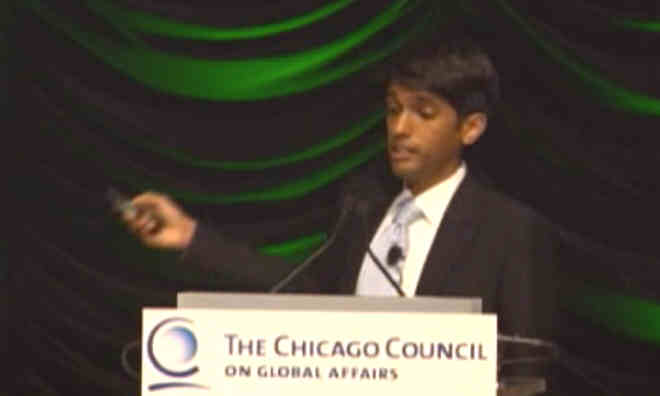The Chicago Council Global Food Security Symposium featured five Lightning Presentations, each lasting five minutes, on the “Environment and Agriculture Nexus.” They were chaired by Representative Doug Bereuter, President Emeritus of the Asia Foundation. The presentations shared some of the most innovative perspectives on food and agriculture issues, in a rapid-fire format.
Handling the Heat: Climate Change’s Impact on Agriculture
Dr. Cynthia Rosenzweig, a senior research scientist at the NASA Goddard Institute for Space Studies, began the Lightning Presentations by discussing the impact of climate change on agriculture, and the research being done in investigating that impact. Dr. Rosenzweig began by stating, “climate change will impact agriculture…and it already has.” This basic connection is fundamental, and a critical reality that must be acknowledged across research disciplines. Dr. Rosenzweig acknowledged the challenges involved in climate change research due to the fact that climate change has both positive and negative impacts on agriculture. High carbon dioxide levels are good for crops, and climate change leads to longer growing seasons and greater participation in farming. However, climate change also leads to increases droughts, floods, and pests, and has the potential to cause large price increases. Dr. Rosenzweig also highlighted the work of the Agricultural Model Intercomparison and Improvement Project (AgMIP), a worldwide research community devoted to climate change and agriculture.
Food Security is National Security
Retired U.S. Air Force (USAF) Major General Rich Engel, now director of the National Intelligence Council, discussed the intersection of water and food as a national security issue. Engel defined such an issue as “any…that degrades U.S. national power.” He noted that 70 percent of available water goes to agriculture, and as economic development shifts water usage towards higher-input products like meat, the scarcity of water poses potential security issues. His research as part of the National Intelligence Council did not find that water and food issues on their own caused state instability, but found that in concert with other factors, they can lead to social and political disruption. Furthermore, Engel warned that “terrorists will use food issues as a wedge to drive people away from governments.”
Water-Smart Agriculture
Thirst is an organization devoted to creating a community of kids that cares and thinks constantly about water issues. Mina Guli, founder and CEO of Thirst, gave a stirring presentation on the power of young people to change behavior at scale. Thirst educated 14,000 children in 47 clubs in nine provinces in China over the course of a year. The success surprised even Guli. Thirst was the top trending topic on Weibo (Chinese Twitter), and built a network of kids who were devoted to one of the most critical issues in agriculture, water. Guli believes that a shift away from traditional education and communication is critical in building effective social change, telling the audience, “We’re thirsty for a better world, what are you thirsty for?”
Switched On: Engaging Smallholder Social Networks through Information and Communication Technologies
Rikin Gandhi, CEO of Digital Green, built an organization that, like Thirst, uses innovative educational and communication tools to connect farmers in India, Ethiopia, and Ghana. Digital Green partners with public and private companies to train members of communities to produce videos “by farmers and for farmers.” Gandhi described how these videos are then shown via a projector during women’s self-help groups, using existing social networks to educate farmers. Over 2,600 videos have been produced and the larger social network, FarmerBook, is expanding to 10,000 villages and one million farmers.
Leveraging Science to Meet the World’s Burgeoning Demand for Animal Products
Imagine a world where all leather and meat are produced without killing a single animal. Dr. Gabor Forgacs, co-founder and Chief Scientific Officer at Modern Meadow, believes that this dream is becoming a reality. After developing 3-D bioprinting technology at the University of Missouri in the early 2000s, Dr. Forgacs has applied technology that is used to make human tissue for research to produce animal tissue for meat and leather. Dr. Forgacs recognized the question of “Why do we care?” when we have been producing meat products the same way for “thousands of years.” Yet, the better question Dr. Forgacs asks is “Why do we care now?” Raising livestock is requires high levels of inputs. The leather samples Dr. Forgacs brought with him, made by bioprinting, represent a future that is ecologically sustainable. Without such advances, Dr. Forgacs says “We will not be able to feed everyone on this Earth when we reach 2050.”












